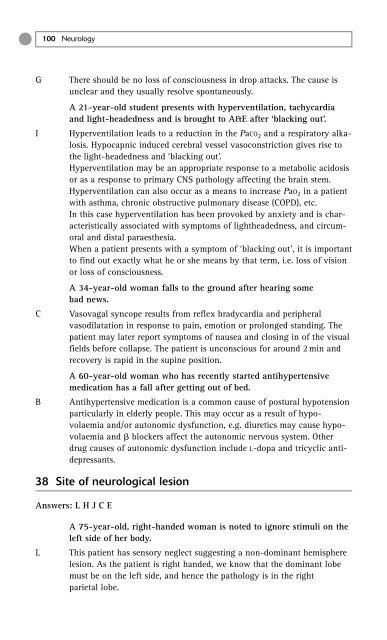EMQs in Clinical Medicine.pdf - Peshawar Medical College
EMQs in Clinical Medicine.pdf - Peshawar Medical College
EMQs in Clinical Medicine.pdf - Peshawar Medical College
Create successful ePaper yourself
Turn your PDF publications into a flip-book with our unique Google optimized e-Paper software.
100 Neurology<br />
G<br />
I<br />
C<br />
B<br />
There should be no loss of consciousness <strong>in</strong> drop attacks. The cause is<br />
unclear and they usually resolve spontaneously.<br />
A 21-year-old student presents with hyperventilation, tachycardia<br />
and light-headedness and is brought to A&E after ‘black<strong>in</strong>g out’.<br />
Hyperventilation leads to a reduction <strong>in</strong> the PaCO 2 and a respiratory alkalosis.<br />
Hypocapnic <strong>in</strong>duced cerebral vessel vasoconstriction gives rise to<br />
the light-headedness and ‘black<strong>in</strong>g out’.<br />
Hyperventilation may be an appropriate response to a metabolic acidosis<br />
or as a response to primary CNS pathology affect<strong>in</strong>g the bra<strong>in</strong> stem.<br />
Hyperventilation can also occur as a means to <strong>in</strong>crease PaO 2 <strong>in</strong> a patient<br />
with asthma, chronic obstructive pulmonary disease (COPD), etc.<br />
In this case hyperventilation has been provoked by anxiety and is characteristically<br />
associated with symptoms of lightheadedness, and circumoral<br />
and distal paraesthesia.<br />
When a patient presents with a symptom of ‘black<strong>in</strong>g out’, it is important<br />
to f<strong>in</strong>d out exactly what he or she means by that term, i.e. loss of vision<br />
or loss of consciousness.<br />
A 34-year-old woman falls to the ground after hear<strong>in</strong>g some<br />
bad news.<br />
Vasovagal syncope results from reflex bradycardia and peripheral<br />
vasodilatation <strong>in</strong> response to pa<strong>in</strong>, emotion or prolonged stand<strong>in</strong>g. The<br />
patient may later report symptoms of nausea and clos<strong>in</strong>g <strong>in</strong> of the visual<br />
fields before collapse. The patient is unconscious for around 2 m<strong>in</strong> and<br />
recovery is rapid <strong>in</strong> the sup<strong>in</strong>e position.<br />
A 60-year-old woman who has recently started antihypertensive<br />
medication has a fall after gett<strong>in</strong>g out of bed.<br />
Antihypertensive medication is a common cause of postural hypotension<br />
particularly <strong>in</strong> elderly people. This may occur as a result of hypovolaemia<br />
and/or autonomic dysfunction, e.g. diuretics may cause hypovolaemia<br />
and blockers affect the autonomic nervous system. Other<br />
drug causes of autonomic dysfunction <strong>in</strong>clude L-dopa and tricyclic antidepressants.<br />
38 Site of neurological lesion<br />
Answers: L H J C E<br />
L<br />
A 75-year-old, right-handed woman is noted to ignore stimuli on the<br />
left side of her body.<br />
This patient has sensory neglect suggest<strong>in</strong>g a non-dom<strong>in</strong>ant hemisphere<br />
lesion. As the patient is right handed, we know that the dom<strong>in</strong>ant lobe<br />
must be on the left side, and hence the pathology is <strong>in</strong> the right<br />
parietal lobe.












